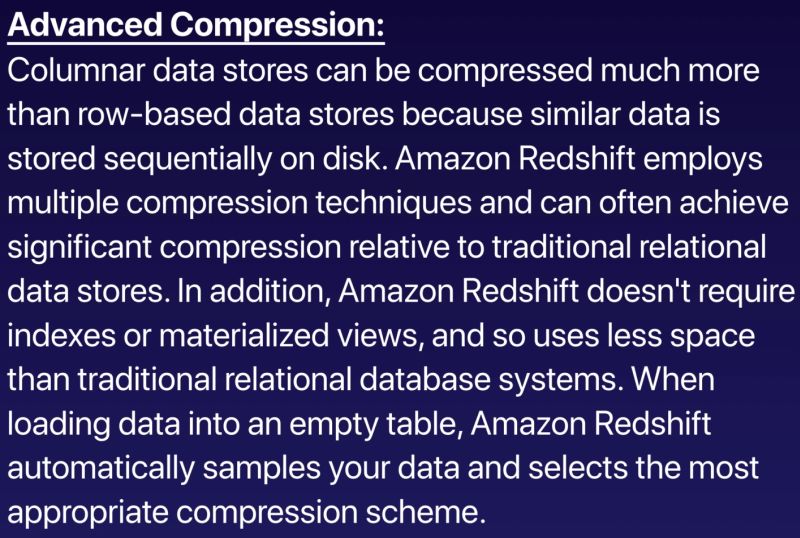AWS RedShift
Amazon Redshift is a fast and powerful, fully managed, petabyte-scale data warehouse service in the cloud.
Redshift is used for business intelligence.
Available in only 1 AZ.
You can enable cross-region snapshots to a different region.
Customers can start small for just $0.25 per hour with no commitments or upfront costs and scale to a petabyte or more for $1000 per terabyte per year, less than a tenth of most other data warehousing solutions.
Can be configured as follows:
| Single Node | Up to 160GB big | |
| Multi-Node | Leader Node | manages client connections and receives queries |
| Compute Node | store data and perform queries and computations (up to 128 nodes) |
Compression

Massively Paralled Processing
- Amazon Redshift automatically distributes data and query load across all nodes.
- Amazon Redshift makes it easy to add nodes to your data warehouse and enables you to maintain fast query performance as your data warehouse grows.
- You can scale out with Redshift by adding more and more nodes behind your leader node.
Backups
Enabled by default with a 1 day retention period.
Maximum retention period is 35 days.
Always attempts to maintain at least 3 copies of your data.
The original and replica on the compute nodes and a backup in S3.
Can also asynchronously replicate your snapshots to S3 in another region for Disaster Recovery.
Redshift Spectrum
Amazon Redshift Spectrum is a feature within Amazon Web Services' Redshift data warehousing service that lets a data analyst conduct fast, complex analysis on objects stored on the AWS cloud.
Priced as follows:
| Compute Node Hours |
Total number of hours ran across all your compute nodes You are billed for 1 unit per node per hour, so a 3-node data warehouse cluster running persistently for an entire month would incur 2 160 instance hours. |
You will not be charged for leader node hours |
| Backup | ||
| Data transfer | Only within a VPC, not outside it |
Security Considerations
Encrypted in transit using SSL.
Encrypted at rest using AES-256 encryption.
By default RedShift takes care of key management.
When you use Amazon Redshift Enhanced VPC Routing, Amazon Redshift forces all COPY and UNLOAD traffic between your cluster and your data repositories through your Amazon VPC.
By using Enhanced VPC Routing, you can use standard VPC features, such as VPC security groups, network access control lists (ACLs), VPC endpoints, VPC endpoint policies, internet gateways, and Domain Name System (DNS) servers.
You use these features to tightly manage the flow of data between your Amazon Redshift cluster and other resources.
When you use Enhanced VPC Routing to route traffic through your VPC, you can also use VPC flow logs to monitor COPY and UNLOAD traffic.
If Enhanced VPC Routing is not enabled, Amazon Redshift routes traffic through the Internet, including traffic to other services within the AWS network.
By default, you cannot create a flow log for your Amazon Redshift cluster.
You have to enable Enhanced VPC Routing and set up the required VPC configuration.
Availability
Currently only available in 1 AZ.
Can restore snapshots to new AZs in the event of an outage.
